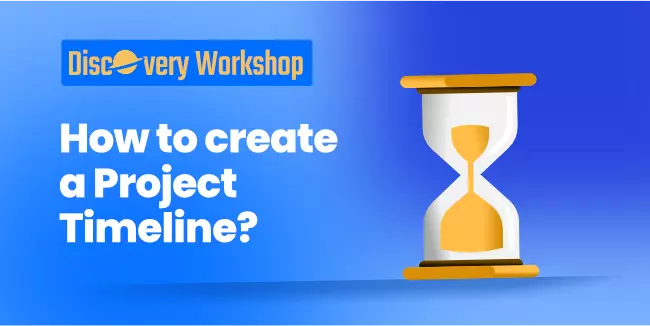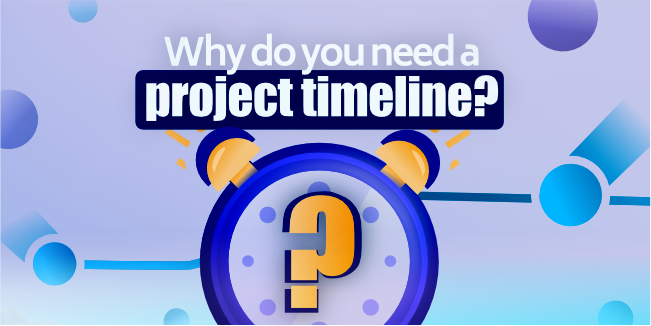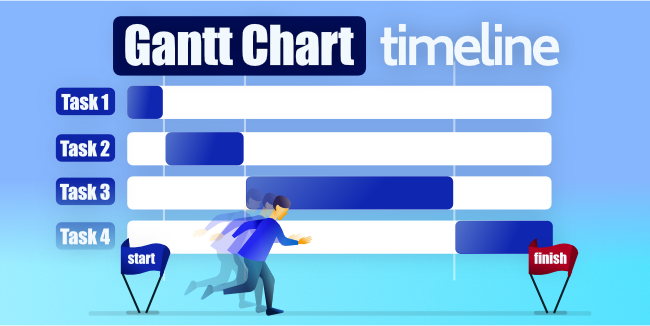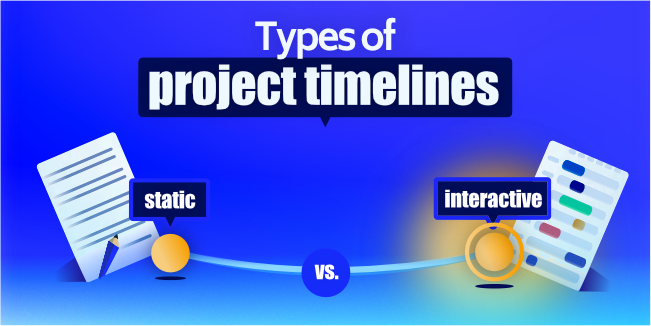discoveryphase
productdesign
projecttimeline
discoveryworkshop
How to create a project timeline?

The process of creating your digital product is very demanding, and a lot is going on in it. And yet to be successful, you everything must tie up loose ends. Having so many stages of our study in the Discovery Workshop behind us, it is not difficult to forget about some crucial issues.
It is where Project Timeline comes in. You will find out why it is essential and its impact on the final product in this article, the seventh in our Discovery Workshop series.
What is a project timeline?
The chronological order of activities and occurrences in your project from beginning to end is a project timeline. It documents what portions have previously passed, what is presently taking place, and what should be completed. It implies that being on the project tracks aids in the process. It's critical to have adequate professional abilities to construct a correct chronology.
Timelines can include a variety of elements depending on your needs and preferences. There are specific components that every timetable must-have, regardless:
- The list of things to be completed.
- The start and end dates of tasks are shown here.
- Tracking time for each operation is essential so that you may determine how long it takes your team to complete any given task.
- Task dependencies.
A project timeline is a canvas of project deliverables. It serves as a comprehensive yet straightforward visual overview of a project's progress from start to end. A detailed timetable depicts a roadmap for your project, including milestones, activities, dependencies, and delivery dates. It determines the capacity of your project and creates an expected timetable for it.
The project management timeline is one of the deliverables after the Discovery Workshops.
Why do you need a project timeline?
Ok, right now you have knowledge about the definition, but why do you need project management timelines for your digital products? It is not important if you have a small or complex projects, in the big picture a project timeline helps you with:
- Determining the capacity of your project - how much can be done in a certain time period
- Creating an expected timetable for your project - when will the project be delivered
- Managing risks - what can go wrong and when
- Communicating to stakeholders - what will be delivered and when
Planning is thought to be linked with project efficiency, cost control, time and quality targets, and overall project success as well as company and corporate objectives by experts.

OK, you know about the definition right now, but why do you need project management timelines for your digital products? It is not essential if you have a small or complex project; in the big picture, a project timeline helps you with:
- Determining the capacity of your project - how much can be done in a specific period of time
- Creating an expected timetable for your project - when will the project be delivered
- Managing risks - what can go wrong and when
- Communicating to stakeholders - what will be delivered and when
Experts link planning with project efficiency, cost control, time and quality targets, overall project success, and company and corporate objectives.
The advantages of having a project timeline at each phase of the process are numerous. A timeline is a valuable tool for keeping everyone on the same page about project progress. It keeps everyone in the loop, from team members to clients, and aids in visualizing project development. There's a long list of reasons why project planners who create project timelines have an advantage. Let's look further into the treasure trove to discover what a reasonable project management timeline entails. These are some key elements:
- A complete plan for the entire project. A project planning timeline is a straightforward visual representation of a project from beginning to end, showing how all the pieces of your plan connect. It binds all necessary components together to put the project plan into action.
- Keeps the broad view insight. The project timeline is a single view that provides essential information about the progress of your project.
- Visualizes the team's major goal. Project schedules enable employees to see how they fit into the process and understand their contribution. Everyone enjoys being in control from time to time. When project owners maintain the timeline open, this is precisely what happens.
- Keeps everyone informed and on track. Project management timelines make project activities visible to everyone involved and stakeholders. It also aids in establishing client confidence.
- Analyzes time and dates to track the chronological order of events. The order of tasks in a project is often conveyed through timelines, which help to show how long it will take to complete various activities.
- Reveals dependencies and eliminates bottlenecks. A timeline is an excellent way to illustrate dependencies. Suppose there's a method to be alerted of dependency violations. It's essential to have a structured timeline to avoid any bottlenecks.
- Communicates how the project is affected by the change. During a transition, the best you can do is to explain how changes will affect the project's personnel and the completion date. Project timeline software like Forecast allows you to make adjustments on the go, modifying the timetable and seeing it reflected immediately. The project timeline makes you increase the likelihood of achieving your project goals. We're going to move on to study a project timeline in action, so you don't get overwhelmed by the theory.
How to make a project timeline step by step?
After concept validation, determining the viability of your product and creating a product roadmap, which is among the first steps in our Discovery Workshop, we begin with project timeline construction. How can you ensure that your project timetable is both organized and successful? We've got a secret to share with you. So successful project timeline contains:
Create a project brief
A project brief should be prepared for each project to ensure that all stakeholders know the plan. It is a detailed action plan that explains the purpose, goals, milestones, and overall vision of the project. The following list contains some examples of questions that a project brief should answer:
- What are the goals of the project, both internal and external?
- Which stakeholders (internal and external) are involved in the project? What are their roles?
- What is the project timeframe?
- What are the key milestones of the project?
Split the project into milestones

Let's speak about milestones. It's critical to break down the project into milestones - larger portions of work that signal significant progress in the project - as soon as you've gathered all of your project requirements and acquired the required data. The project schedule is divided into phases that will assist you in dividing the timeline and simplifying project planning from this stage on. In future communications with stakeholders, who are generally more interested in the significant project phases than, for example, activities, painting the project with broad strokes first will be beneficial.
Prepare a list of activities to be performed/ Break each milestone into bite-sized tasks
To create an effective project timeline, you must first list everything that must happen - from planning it to achieving the final results (whether it's a report or an event). Consider all of the phases - large and little - that will see your project completed on schedule and budget, and include them in this checklist.
The ability to drill down and see the project at a more accurate level will not only assist the team in seeing their function in it, but it will also enable you to get real-time reporting. Breaking objectives into activities means keeping communication lines open and making the team a part of the process. To figure out what it takes to finish each task, you'll need their full involvement and knowledge.
Break it down into smaller, simpler subtasks when you have a long or complex step. Not only will this assist you in determining the full extent of each action, but it will also allow you to ensure that nothing is overlooked.
Determine dependencies between tasks
Certain phases might be done in parallel during the project, especially if different team members are in charge of each activity. There are, however, some activities that cannot be started until another step is completed. To put it another way, some actions are contingent on the completion of others. One of the many reasons the timeline is so crucial is that it shows you where and when each step will take place. It allows you to keep track of where you are about all the other tasks on your list. Because you have task lists for each milestone, you'll need to indicate whether the particular sequence should be followed and one task relies on another. Tasks can only be done if other tasks are completed in some cases. IT firms are especially susceptible to this since software engineers may not start working on one part of the project until their partners have finished theirs. You can assign tasks right now!
Estimate how long it will take to complete each step
The next step is to schedule the time required to complete each project component. On the one hand, you must give your staff enough time to accomplish each activity and meet the deadline; on the other hand, you must also provide them with sufficient time. Knowing how long each activity will take may help you prepare for it and prioritize your steps. Our experience creating digital products (web and mobile) allows us to forecast a time fairly. As a result, during the workshop, you get a document with a timeline, budget, and an overview of the entire project (functionalities, recommendations).
Share your timeline with stakeholders
Take into account how we incorporated all stakeholders to begin our project brief? The same should be done with the timeline, allowing everyone involved in the project access. They will value your plan's clarity. The more you make it simple for them to complete their part of the job, the more grateful they will be. If you use some project management tool, you can share that easily.
Types of project timelines
Now, a few words about the types of project timelines. There are many different project timelines, such as Gantt Charts, Chronology Charts, and Vertical Bar Timelines. Here's how they differ and how they might be used.
Gantt Chart timeline
Gantt charts have been around for a century, but they're still popular among project managers. They provide an overview of the project's timeline, showing the overall picture of any size project.

Every project management software has a Gantt chart timeline, in one form or another, that allows you to get a good picture of your project. The most common type is a horizontal line with time periods. All project activities, actions, and tasks are labeled along the line. It's quite simple to tell what has occurred before, now.
Interactive and real-time Gantt charts allow you to view the project's progress up to the minute, based on time registrations and connections between different activities. Gantt charts vary by industry and project, but they all have certain features that are common across industries.
- The project's start and end dates
- What tasks the project consists of
- Task assignees
- When tasks start and finish
- The order of tasks, links, dependencies, and overlaps
- Task duration
- Project delivery date
- Project, milestone, and task progress
Historical timeline
An excellent timeline for showcasing essential milestones is a historical timeline. It is a chart that depicts events in chronological order, from left to right or top to bottom. It may produce an overview of your project's or company's historical perspective by displaying the sequence and succession of events.
Vertical chart timeline
A vertical chart timeline displays the quantity of something acquired over a period of time, such as weekly, monthly, or yearly. They can be used to display the company's monthly recurring revenue or applied to other circumstances where money is involved. In general, it's a good choice for finance teams and anybody trying to keep data records sweet and straightforward. Many businesses use the following marketing timelines to show the quantity of leads or traffic generated each month.
If you're unfamiliar with the advantages of project timeframes, here are some examples of why they may help you plan, execute, and monitor your projects. Gantt charts are essential for project managers, if not a must-have. Therefore we'll concentrate on them from here.
Static vs. interactive project timelines
Project timelines can be either static or interactive. A static timeline remains unchanged, such as a paper or print-based one. It's time wasted, and it has to be re-planned and re-done from the ground up every time something new occurs, not to mention the fact that it lacks functionality to show you real-time progress.

Project managers enjoy using dynamic interactive project timelines since they are flexible. An Interactive timeline is made possible through project time management software that allows you to alter the scope of work as you go. It automates re-planning, communicates progress, and may even display schedule variance while the project is still running. You have a lot of project timeline software that you can use.
Conclusion
We hope you found this essay useful in better understanding how to construct a project timeline and why it is essential. The documentation stage of our Discover Workshop comes to an end with the production, where we provided a project plan for the whole team. Planning is crucial because it helps project owners keep track of their projects and avoid errors. Our Discovery Workshop, we help our clients structure the idea and build the foundations for achieving the intended business goals through technical consulting. Project timeline creating is one of the several things you receive.

This article is part of our Discovery Workshop series
What is Product Design? What is the Product Discovery and Product Discovery Process? Tips and Techniques for Effective Product Discovery Process Idea Validation in Practice Product Roadmap - how to write user stories and user flows? How to choose a tech stack for your project? Now readingHow to create a project timeline? How to create a project budget? Functional Requirements Document for your Product What is a Prototype? Build your MVP (Minimum Viable Product) the right way - step by step guide by mDevelopers